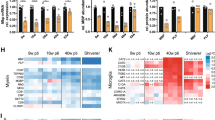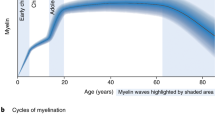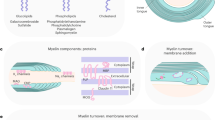Abstract
MORPHOLOGICAL evidence indicates that myelin is formed in the central nervous system by the wrapping of macroglial plasma membrane about the axon1,2. Proliferation of glial cells occurs shortly before myelination3, and connecting processes between oligodendrocytes and the developing myelin sheath have been noted4. This concept is supported by experiments with isotopes, which suggest that lipid from the microsomal fraction, which would include glial plasma membrane, is utilized in myelin formation5. Myelin would therefore be expected to have the same or similar chemical composition as that of the oligodendroglial plasma membrane and myelin lipids would be present in the brain during the stage of glial proliferation immediately before the first appearance of myelin rings. Analysis of glial-rich fractions from adult rat brain (Table 1), however, shows that they contain much less cerebroside and more phospholipid than is present in myelin, and hence that the composition is similar to that of most other tissue membrane systems. This same type of lipid composition is found in glial tumour tissue (Table 2) and in the glial-rich brain just before the onset of myelination9. In order to examine the sequence of biochemical events further, myelin has been isolated from the brains of rats from 10 days old onwards. The early myelin fraction was found to have a low cerebroside content and to be rich in phospholipid and thus similar to the lipid composition of glia (Table 1). Only when rats were 30 days old was the adult myelin lipid ratio attained. Morphological, enzyme and chemical examination of myelin from 12 day old rats does not suggest that this fraction is heavily contaminated by other subcellular fractions. Thus little succinic dehydrogenase and ATPase activity and only small amounts of nucleic acids are found in the preparation. It therefore seems possible that early myelin consists essentially of oligodendroglial plasma membrane and that later insertion of cerebroside into the myelin lamella produces the stable mature membrane structure. This hypothesis, which attributes a key role to cerebroside, may be pertinent to neurological diseases in which defects in cerebroside content have been noted.
This is a preview of subscription content, access via your institution
Access options
Subscribe to this journal
Receive 51 print issues and online access
$199.00 per year
only $3.90 per issue
Buy this article
- Purchase on Springer Link
- Instant access to full article PDF
Prices may be subject to local taxes which are calculated during checkout
Similar content being viewed by others
References
Luse, S., J. Biophys. Biochem. Cytol., 2, 777 (1956).
Peters, A., J. Biophys. Biochem. Cytol., 8, 431 (1960).
Bensted, J. P. M., Dobbing, J., Morgan, R. S., Reid, R. T. W., and Payling Wright, G., J. Embryol. exp. Morph., 5, 428 (1957).
Bunge, M. B., Bunge, R. P., and Pappas, G. D., J. Cell Biol., 12, 448 (1962).
Davison, A. N., and Gregson, N. A., Biochem. J., 98, 915 (1966).
Rose, S. P. R., Nature, 206, 621 (1965).
Davison, A. N., and Graham-Wolfaard, E., J. Neurochem., 11, 147 (1964).
Cuzner, M. L., Davison, A. N., and Gregson, N. A., J. Neurochem., 12, 469 (1965).
Cuzner, M. L., and Davison, A. N. (unpublished results).
Author information
Authors and Affiliations
Rights and permissions
About this article
Cite this article
DAVISON, A., CUZNER, M., BANIK, N. et al. Myelinogenesis in the Rat Brain. Nature 212, 1373–1374 (1966). https://doi.org/10.1038/2121373a0
Issue Date:
DOI: https://doi.org/10.1038/2121373a0
This article is cited by
-
Element Distribution in Visual System, the Optic Chiasma, Lateral Geniculate Body, and Superior Colliculus
Biological Trace Element Research (2011)
-
Relationships Among the Hippocampus, Dentate Gyrus, Mammillary Body, Fornix, and Anterior Commissure from a Viewpoint of Elements
Biological Trace Element Research (2011)
-
The effect of undernutrition on the development of myelin in the rat central nervous system
Lipids (1971)
-
Protein patterns during final differentiation of some rat organs
Wilhelm Roux' Archiv für Entwicklungsmechanik der Organismen (1970)
Comments
By submitting a comment you agree to abide by our Terms and Community Guidelines. If you find something abusive or that does not comply with our terms or guidelines please flag it as inappropriate.



